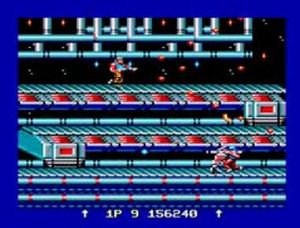Amstrad CPC[edit]

Ported by Ocean, in 1987. This version of the game has a few differences from the arcade version.
- There is no scrolling. When you approach the edge of the screen (approximately 1/3rd screen-size away from the edge), the camera instantly moves to the next position.
- The first corridor timer is 90 seconds, and the second is 2 minutes.
- The barrier causes the character to blink, and is also shown as a timer in place of the score.
- The waterfall boss is visible even before you reach the top. You can defeat the boss while still protected by the barrier you collected at the beginning of the stage.
- The second terminal boss has its two targets split in two as normal, but they more quickly return to their original position. They can also be one-shot killed by the laser.
- Snow Field is skipped. There is also no tanks or giant mini-bosses.
Commodore 64[edit]
The Commodore 64 was ported by Ocean, under the name Gryzor. It is based on the arcade version of the game, but is more difficult due to implementation.
- Weapons are slow-firing, even with the rapid fire powerup. However, you move faster compared to the NES version.
- Stage 1 requires you to advance directly to the door before it becomes vulnerable.
- As with the arcade version, you had to complete the corridor section within a limited time. Unlike the arcade version and other ports, the time allowed is much lower: you only have 40 seconds for the first corridor, and 55 seconds for the second. Rolling floor grenades were omitted.
- The waterfall stage is shortened in one of the two Commodore 64 ports.
- The second terminal boss has one small soldier at the top, running along. It makes one shot before jumping down; to avoid the jump, avoid standing under the side
- The tank appears once. If you have the barrier, you can run past the mouth without killing it.
- The spike claws in Hangar are replaced by electric barriers that turn on and off.
- The final boss is only protected by mouths, and doesn't launch spiders. The projectiles from the mouths bounce off the floor and ceiling.
-
Replacement Waterfall boss
-
Hangar, right against unpredictable electric barriers
-
Final opponent, guarded only by mouths
MSX2[edit]
An MSX2 version of Contra was released by Konami exclusively in Japan on May 26, 1989. The MSX2 version of Contra greatly differs from the arcade and NES versions. Due to hardware limitations of the MSX2, the game does not scroll but instead uses flip-screens like Konami's other MSX2 games such as the original Metal Gear and Vampire Killer. The player is given a life gauge, allowing their character sustain more than one shot before losing a life. There are two main power-ups in the MSX2 version, a Falcon-shaped power-up that increases the player's walking and shooting speed, as well as a gun-shaped power-up which allows the player to change their current weapon. After picking up the weapon power-up, the player can choose between the default Normal Gun or four other weapons. The Spread Gun is not featured in this version, replaced by Rear Gun similar to the tailgun in certain Gradius games, which fires at two directions at the same time. The MSX2 Contra is composed of 19 stages. The first nine stages are based on the arcade version (which excludes the Hangar stage), while the final ten stages are new to this version. Unlike the arcade and NES versions, the MSX2 version is single-player only.
The MSX2 version of Contra was released for the Wii Virtual Console in Japan on February 2, 2010.
NES[edit]
For more information about this conversion, please see the NES guide.
-
Japanese cover
-
NES cover (US)
-
NES cover (EU)





